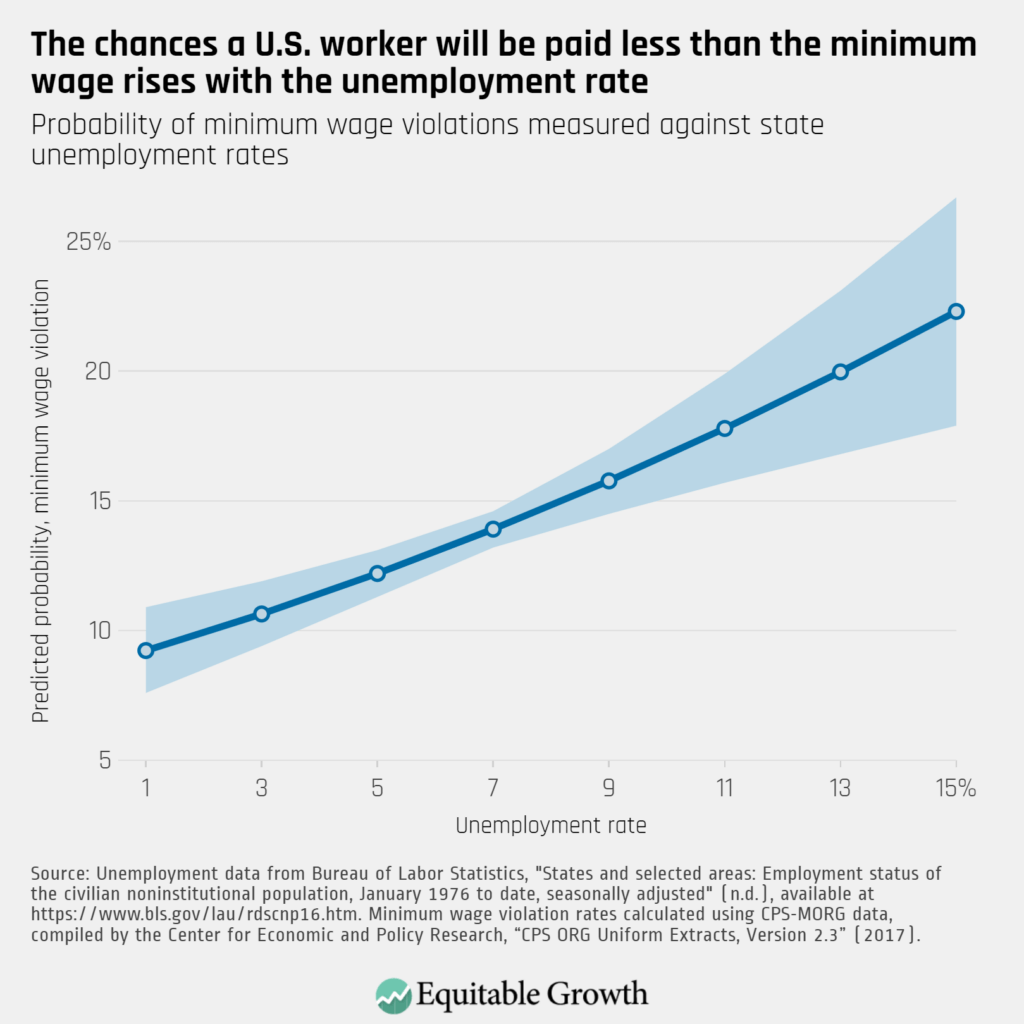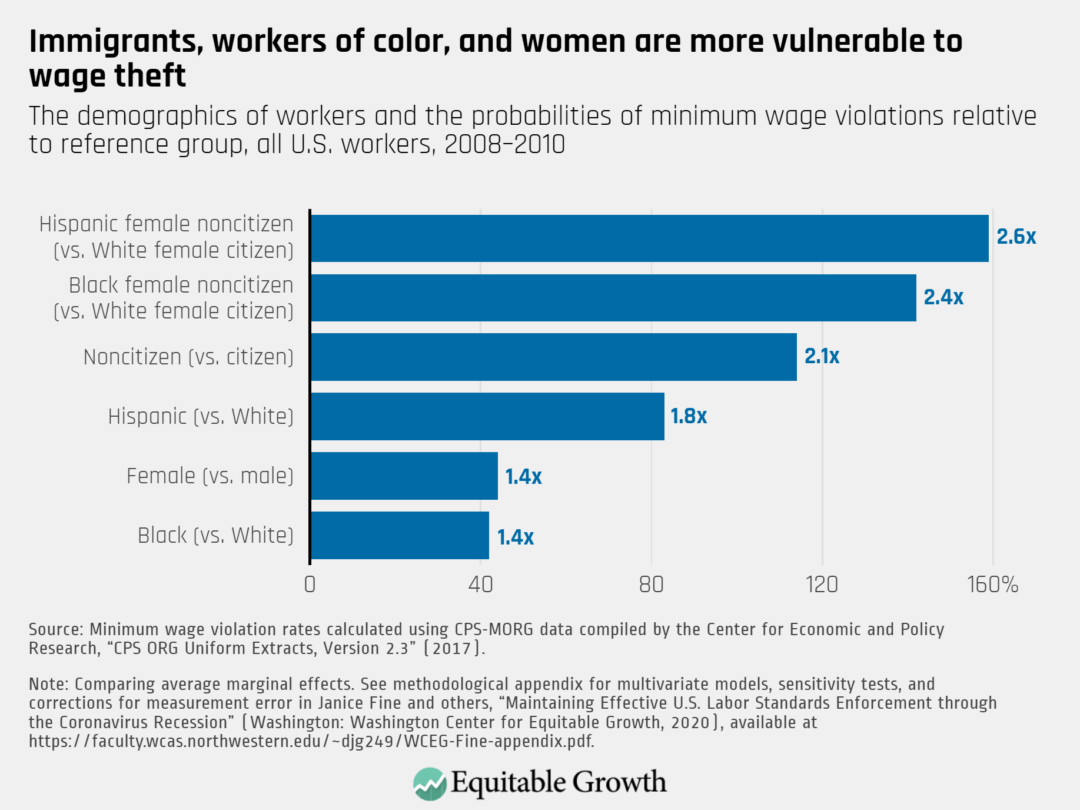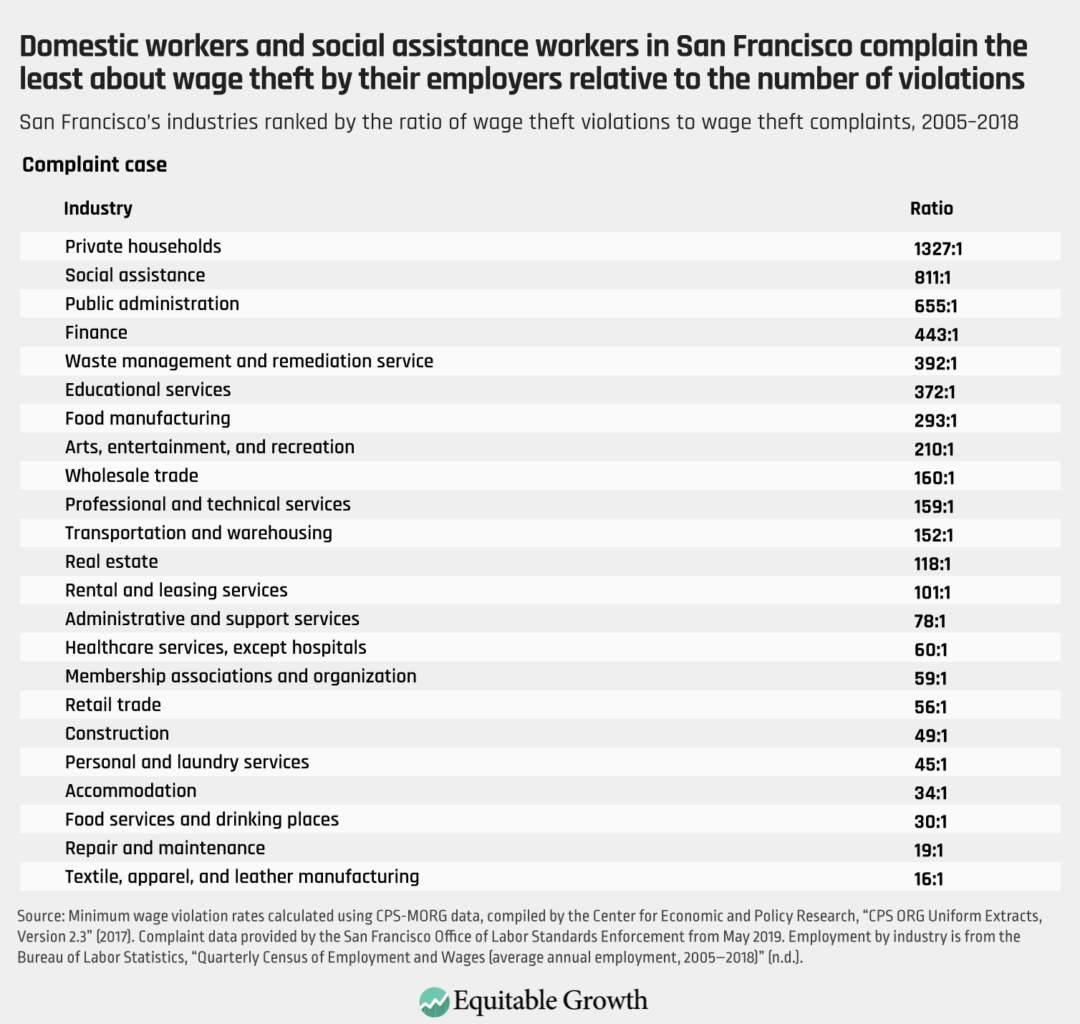Strategic enforcement and co-enforcement of U.S. labor standards are needed to protect workers through the coronavirus recession

This essay is part of Boosting Wages for U.S. Workers in the New Economy, a compilation of 10 essays from leading economic thinkers who explore alternative policies for boosting wages and living standards, rooted in different structures that contribute to stagnant and unequal wages. The authors in the new book demonstrate that efforts to improve workers’ access to good jobs do not need to be limited to traditional labor policy. Policies relating to macroeconomics, to social services, and to market concentration also have direct relevance to wage levels and inequality, and can be useful tools for addressing them.
To read more about Boosting Wages for U.S. Workers in the New Economy 20 and download the full collection of essays, click here.
Overview
The coronavirus pandemic and resulting recession combine to create a uniquely dangerous time for low-wage workers. U.S. unemployment hit record highs in April 2020 and remains persistently elevated. And employers are more likely to break labor laws and take advantage of low-wage workers, both in sectors where labor law violations are traditionally high and in sectors that normally have higher rates of compliance. These dangers confront workers because in a pandemic-induced recession they are in even weaker positions to speak up for themselves, report violations, or find new jobs.
Evidence from the Great Recession of 2007–2009 indicates that high levels of unemployment weakened the labor market power of those low-wage workers who remained employed. Our recent research on minimum wage violations during the Great Recession found dramatic increases in these violations that disproportionately harmed noncitizens, Latinx, Black, and women workers.1 It is therefore critically important that federal, state, and local labor standards are vigorously and strategically enforced during times of economic stress.

Webinar: How to strengthen U.S. labor standards enforcement to protect workers’ rights
May 20, 2021 2:00PM – 3:30PM
Yet state and local governments are facing extraordinary budget deficits. This fiscal crisis makes it even more difficult for state and local labor enforcement agencies to respond to violations, just when this work is needed most. This essay summarizes our findings and proposes two complementary frameworks for greatly strengthening enforcement:
- Strategic enforcement, in which labor standards enforcement agencies target high-violation industries and maximize the use of enforcement powers to increase the cost of noncompliance
- Co-enforcement, in which labor standards enforcement agencies engage in sustained partnerships with worker centers, unions, legal advocacy organizations, and other community-based organizations embedded in low-wage worker communities and high-violation sectors
We then put forward some federal policy recommendations to enact these two robust enforcement standards.
The problem: High unemployment will likely lead to dramatically increased violations while state and local governments face massive budget deficits
The coronavirus pandemic and the resulting disruption to the global economy is unprecedented in modern times. In February 2020, unemployment in the United States was at 3.5 percent, a 50-year low.2 By April 2020, unemployment rose to a staggering 14.7 percent, the largest increase in the history of the series.3 In just 2 months, job losses due to the pandemic surpassed the total number of jobs lost from December 2007 to June 2009 during the Great Recession.4 These job losses disproportionately affected Latinx, Black, and female workers.5 By the end of 2020’s third quarter, the unemployment rate remained at 7.9 percecnt, with 12.6 million people without a job.6
Like the current recession, Black and Hispanic communities also faced disproportionate rates of unemployment during the Great Recession. Black unemployment peaked at 16.8 percent, while the Hispanic unemployment rate reached 13 percent, both of which were markedly higher than the 9.2 percent high for White workers.7 Though shocking, these outcomes are unsurprising, as workers of color are disproportionately employed in industries and occupations that are more vulnerable to cyclical downturns.8
While the circumstances surrounding the Great Recession are markedly different, data from that period provide insight into what we can anticipate for workers amid the current coronavirus recession. Using Current Population Survey data, we estimate that the probability that any given low-wage worker would be paid below their applicable minimum wage ranged from about 10 percent to about 22 percent between 2007 and 2013, with each percentage point increase in their state’s unemployment rate predicting, on average, almost a full percentage point increase in the probability they would experience a violation. The average amount of money these workers lost to minimum wage violations was 20 percent of their hourly wage, or $1.46 per hour on average. (See Figure 1.)
Figure 1

Notably, the negative consequences of the Great Recession were shouldered by some groups of workers more than others. To assess the relative likelihood that workers in key demographic groups would experience minimum wage violations (relative to the reference group), we examine all workers during the height of the recession and its immediate aftermath in 2008–2010. We find that the probability of experiencing minimum wage violations was much greater for women, noncitizens, Hispanic, and Black workers. When the interaction of gender, race, and citizenship are taken into account, the effects of discrimination are compounded. Hispanic women who were not U.S. citizens, for example, were 2.6 times more likely to experience a minimum wage violation than White female citizens, while noncitizen Black women were 2.4 times more likely. (See Figure 2.)
Figure 2

New research suggests that minimum wage laws can reduce the racial earnings divide, which is now larger than it was in 1979,9 as well as income divides.10 But when the right to be paid the minimum wage is not realized, policymakers can expect the efficacy of such efforts to be curtailed, with dire consequences of minimum wage violations for workers and their families. A 2017 Economic Policy Institute report found that failure to pay workers the applicable minimum wage for all reported hours increased the percentage of workers living in poverty from 14.8 percent to 21.4 percent in the 10 most populous states.11
In addition to the extraordinary job losses in the private sector caused by the coronavirus recession, the shuttering of the U.S. economy also sharply reduced public-sector revenues, which, combined with unanticipated expenditures related to the coronavirus recession, leaves state and local governments at all levels with substantial deficits, leading inexorably to more and more mass layoffs of public-sector workers.
As a result of state and local budget cuts, funding for labor standards enforcement is almost certain to decrease. Troublingly, even in times of economic prosperity, there is little funding for labor standards enforcement. A survey by two of the authors of this essay, alongside Greg Lyon at Rutgers University, conducted in 45 states and cities that enacted labor standards laws between 2012–2016, found that 27 percent of the states received no additional funding at all for enforcement, and another 13 percent received $50,000 or less. At the city level, more than 50 percent have no funding whatsoever to carry out the new policies, and another 22 percent have $50,000 or less.12
This lack of funding at the state and local levels means that even in some jurisdictions that have passed higher state and local minimum wage policies, the U.S. Department of Labor’s Wage and Hour Division is effectively the sole enforcement agency working to ensure compliance. The division, though, has its own resources deficit. As of May 1, 2020, for example, it employed 779 investigators to protect more than 143 million workers, which is significantly fewer than the 1,000 investigators employed in 1948 when the division was responsible for safeguarding the rights of only 22.6 million workers.13
Research by labor economists demonstrates that U.S. employers weigh the costs and benefits of minimum wage compliance and are more likely to violate the law if there is a low probability of being investigated or face minimal fines even if they are caught.14 Without resources for effective enforcement, hard-won state and local minimum increases are at great risk. More broadly, unaddressed wage theft facilitates unfair competition where weaker firms in an industry are able to undercut compliant firms. Widespread wage theft can undermine the whole structure of wages in an industry.
The challenge: Complaint-based enforcement overlooks violations against vulnerable workers
Labor enforcement agencies across the United States overwhelmingly engage in a reactive complaint-based approach to enforcement, in which agencies assume that when workers experience a violation, they will complain to the appropriate public agency that will then investigate it. Complaint-based enforcement became the default mode of enforcement in the early years of the Fair Labor Standards Act of 1938 and largely remained so until the Obama administration.15 Likewise, in our survey previously cited above, 70 percent of cities surveyed indicated their enforcement is complaint-driven while 54 percent of states interviewed said the same.16
Despite the prevalence of complaint-based enforcement, the model is inadequate. First, complaint-based enforcement has failed to keep up with the growth of subcontracting and attenuated labor and product supply chains—new firm and industry structures and strategies and employment arrangements that continue to evolve.17 Low-wage industries in particular are experiencing an explosion of what David Weil, the former head of the federal Wage and Hour Division, calls the “fissuring” of the employment relationship.18
Fissuring occurs when companies shift the direct employment of workers to other business entities through increased reliance on strategies such as subcontracting, use of temporary employees, and independent contracting arrangements.19 Often, firms are embedded in subcontracting networks, in which one large firm or a few firms are setting the terms of exchange but are not the employers of record for the purposes of labor standards enforcement.
Second, complaint-based enforcement tends to embrace an individualized regulatory approach that conceives of each individual case—or worker complaint—as an isolated and idiosyncratic incident. This means that even a high number of individual cases or complaints are unlikely to lead to structural reforms across an industry. Agencies handle each worker complaint as a separate transaction that yields no other regulatory actions beyond opening and closing the particular case at hand; the case itself is considered apart from the broader structural context from which it emerged and without an eye toward systemic reform.20
Third, research on minimum wage enforcement suggests that workers in some of the industries with the worst conditions are much less likely to complain about wage theft.21 Comparing complaint rates to estimates of underlying minimum wage violations in various state and local jurisdictions across the United States, we find an insufficient overlap to justify enforcement based solely on complaints.
Even in some of the most progressive cities with well-funded local enforcement agencies, there are stunning gaps between the industries with the highest rates of complaints and those with the highest violation rates. Our study of San Francisco, for example, demonstrates that in many industries, the number of minimum wage complaints reported to the San Francisco Office of Labor Standards Enforcement was significantly lower than estimated violation rates in those industries. We compare the actual number of complaints submitted to the agency to estimates of minimum wage violations by industry in 2005–2018, again using CPS data. We find that violations in the private households, social assistance, and food manufacturing industry sectors were among the highest of any industry, but workers in these three industries made very few complaints to the city’s labor standards enforcement agency.22 (See Table 1.)
Table 1

Another way to think about the extent of the discrepancy between individually driven complaints and minimum wage violations is to calculate a ratio for each industry.23 In San Francisco, more than 1,300 violations are estimated to occur for every one worker complaint in the private households industry, which largely employs child care workers, personal and homecare aides, and housecleaners. In social assistance, an industry in which a significant number of child care workers, cooks, and homecare and home health aides work, more than 800 violations are estimated to occur for every one complaint. (See Table 2.)
Table 2

Such results demolish the premise of the complaint-based enforcement model—that workers whose rights are violated will speak up. On the contrary, we find that some of the most regularly exploited workers are among the leastlikely to complain. In the complaint-based enforcement model, quiet industries are presumed to be compliant industries, not industries where workers are suffering silently.
The consequences of this faulty assumption are grave. Where enforcement is most needed, few investigations are triggered. Meanwhile, labor standards enforcement agencies inefficiently devote resources to pursuing complaints in far more compliant industries. These inequalities are only likely to be exacerbated in the context of a recession, and particularly amid the current pandemic-induced recession.24
The discrepancy between individual complaints and business violations is caused by asymmetries of power between low-wage workers and the firms for which they work. Workers with the least power and few alternative employment options face barriers that keep them from stepping forward to complain much of the time.25 In a recession, high unemployment increases workers’ desperation to maintain any job, thus tipping the power imbalance even further toward firms. Again, looking back at violations during the Great Recession is instructive. We find that workers who belonged to a union were more than three times less likely to experience a minimum wage violation than workers who did not belong to a union.
Just as noncitizen workers and workers of color became more vulnerable during the Great Recession, we expect, given the current coronavirus recession, that they will once again become highly vulnerable but unlikely to file a complaint out of fear of losing their jobs.
Frameworks for changing U.S. labor enforcement standards
Given the likelihood of the persistence of the coronavirus pandemic and recession, what is the most effective framework to enforce labor standards laws when violations increase and enforcement resources are further diminished? There are two primary, interrelated frameworks that answer this question: strategic enforcement and co-enforcement.
Strategic enforcement of labor standards
Strategic enforcement is a form of systemicregulation that conceives of each violation as a potential signal of a broader pattern of labor market violations.26 Unlike complaint-based enforcement, in which each case is typically processed as an isolated or idiosyncratic incident, a strategic enforcement model analyzes complaints for underlying causes and targets enforcement resources to high-violation industries.
As articulated by David Weil, the overarching goal of strategic enforcement is “to use the limited enforcement resources available to a regulatory agency to protect workers as prescribed by laws by changing employer behavior in a sustainable way.”27 At the federal level, the main components of strategic enforcement include a proactive, rather than reactive, approach to investigations, targeting industries high in violations but low in complaints, maximizing the extent of legal penalties imposed on violators, informational campaigns to businesses and workers, strategic communications and signaling to employers, robust compliance agreements with violators, and using data to measure effectiveness.28
Of course, federal, state, and local enforcement agencies operate in vastly different political climates and with a wide variety of statutory powers and bureaucratic limitations. Accordingly, strategic enforcement cannot be cast in “one size fits all” or “all or nothing” terms. Instead, there is a full complement of tools and techniques that agencies can use at each stage of the process to achieve broad, long-term compliance. Agencies can adopt and incorporate some of these strategic practices and work toward adopting others by taking on administrative and statutory limitations over time. (See Figure 3.)
Figure 3

Strategic enforcement addresses gaps created by traditional complaint-based enforcement in several ways. First, the use of proactive investigations in targeted industries means enforcement resources are more likely to identify and reach vulnerable workers who are unlikely to complain. Agencies looking to target high-risk sectors in this pandemic-triggered recession should look to those low-wage sectors in which unemployment rates are the highest. These include food service and drinking places; accommodation; arts, entertainment, and recreation; transportation and warehousing; personal and laundry services; private households; retail trade; administrative and support services; and social assistance.29 Likewise, industry research to identify industry structure, influential employers, and widespread noncompliant industry practices help agencies target employers that are likely to get the attention of others in the industry.
In addition to proactive investigations, strategic enforcement includes implementing a triage system to sort complaints, so that high-violation industries with high- and low-complaint rates are prioritized,30 maximizing the use of statutory tools that are designed to address common enforcement impediments and disincentivize bad-faith employers from acting to obscure noncompliance,31 and assessing high damages and penalties in addition to back wages owed to deter future violations.32
Addressing the fissuring of employment relationships is also key. Holding those with the most power and reputational risk in the contracting relationship liable for downstream violations through joint employment analyses, combined with a press strategy to publicize investigations, is crucial for maximizing the ripple effects of strategic enforcement.33 Finally, robust collections efforts and tools that ensure workers in fact receive money they are owed and innovative settlement terms that address the root of violations while promoting ongoing compliance are also central components of strategic enforcement.34
Co-enforcement of labor standards
Strategic enforcement is a logical response to the coronavirus recession, but it will not succeed unless it is accompanied by a significant enhancement of workers’ voices.35 Simply put, problems will remain hidden unless workers speak up, yet vulnerable workers will not speak up in isolation. Likewise, as strategic enforcement includes moving to a more proactive investigative approach, it renders co-enforcement—sustained partnerships with worker centers, unions, legal advocacy organizations, and other community-based organizations that are embedded in low-wage worker communities and high-violation sectors—essential to addressing the enforcement challenges created by the 21st century labor market.36
To illustrate this, we must consider why the vast majority of agencies continue to utilize the complaint-based enforcement model. One reason is that complaints often provide a foundation from which to build a strong case. In reacting to a complaint, before an investigation even begins, the agency has a cooperating witness and an array of information that may include the nature of the violations, how the employer may attempt to hide violations, names of management and ownership personnel, and other facts relevant to the case. Worker participation and evidence is particularly important in establishing violations and back wages owed in more difficult investigations, in which employers have no records or have falsified timesheets and payroll records to appear compliant. Without a connection to the workforce on which the agency can build an investigation, proactive investigations can be daunting and the agency may be unable to establish violations are occurring.
Worker organizations have access to information on compliance with labor standards that would be difficult, if not impossible, for state officials to gather on their own.37 It is often only when the organization that has relationships with vulnerable workers has vouched for a government agency that they have been willing to come forward. By building on existing trust between workers and organizations, investigators can gain access to the knowledge and information workers possess about violations.38
Additionally, through their relationships and local credibility, community organizations can educate workers, encourage them to file complaints, and help to gather testimony and documentation. Drawing on workers’ networks, community organizations can also recruit workers from problematic firms and industries by providing a safe space and interpretation and facilitation services, as well as helping state inspectors meet with workers who may be too intimidated to go to a government office. They also exercise a kind of moral power and broaden public support for robust enforcement when they document and publicize egregious examples and patterns of abuse.39
Enforcement agencies face a wide range of political pressures not to engage in vigorous enforcement. Worker organizations can act as countervailing points of pressure and when an investigation is undertaken by an agency, through their relationships with workers, can continue to monitor the employer over time, after inspectors have moved on to new cases.40 (See Figure 4.)
Figure 4

The effectiveness of combining strategic enforcement with co-enforcement is not merely theoretical. One of the greatest success stories comes from California, wherein Julie Su’s appointment as labor commissioner in 2011 placed a longtime advocate from a legal advocacy organization who had seen firsthand the inadequacies of the existing system into a top leadership position. Su revolutionized the enforcement model and internal culture of the agency such that the California Labor Commissioner’s Office marshalled its full powers, sought additional powers from the legislature over time (with the support of labor and community allies), systematically changed management and personnel practices, and brought community partners into the very center of its strategic enforcement efforts.
These changes achieved powerful results. Through its partnerships, the state’s Labor Commissioner’s Office is able to focus its resources on cases of a greater magnitude, resulting in the agency finding more violations per investigation and more wages owed to workers in its history. Under Su, the agency was able to identify many more violations, increasing the ratio of violations to investigations from 49 percent in 2010 to 150 percent in fiscal year 2017–2018, and wages assessed per inspection rose from $1,402 to $28,296 over the same time period. As the Labor Commissioner’s Office noted, “better targeting leads [to] fewer law-abiding employers to be inspected, more unpaid wages to be found, and more citations to be issued per employer.”41
Federal policy recommendations to strengthen strategic enforcement and co-enforcement of labor standards
Given what we know about the impact of the recession on violation rates, the transition to strategic enforcement and co-enforcement is imperative at all levels of government. Maintaining agency budgets to fund strategic enforcement and co-enforcement at all levels of government is a good investment of scarce resources that will better protect the rights of workers and maintain a level playing field for compliant employers.
There are a number of legislative changes, which are more fully outlined here, that should be adopted at the federal level to empower the U.S. Department of Labor’s Wage and Hour Division to implement a robust strategic enforcement and co-enforcement program.42 These include key amendments to the Fair Labor Standards Act to create a number of important strategic enforcement tools, many of which have already been passed at the state and local levels. And they include the creation of a grant program to fund partnerships with organizations that have deep connections to vulnerable, low-wage workers and/or expertise in high-violation industries to facilitate co-enforcement.43
Finally, funding for the federal Wage and Hour Division must be appropriated such that the agency has sufficient staff to protect U.S. workers and compliant employers. As of May 2020, the division employed approximately one investigator per 183,568 workers, a critically insufficient investigator-to-worker ratio. The International Labour Organization has estimated a reasonable benchmark is one investigator for every 10,000 workers, a standard that calls for approximately 14,300 investigators in the United States.44
That’s why, at the very least, funding should be appropriated at a level equal to that requested for FY 2016, wherein the division proposed funding for 2,044 full-time staff.45 These additional enforcement resources should be focused on industries hardest hit by the pandemic and where data indicate violations are high and workers are especially vulnerable, with the goal of achieving ongoing, industrywide compliance.46
Conclusion
The U.S. labor market today is characterized by growing income inequality, pay stagnation, declines in union participation, and deregulation such that the balance of power largely favors employers at the expense of workers. The coronavirus pandemic in particular threatens to exacerbate this power imbalance and undo the progress made in cities, counties, and states that have raised the minimum wage and passed other innovative worker protection laws.
Policymakers should work to maintain hard-fought state and local gains and consider passing additional federal worker protections. In these efforts, they must prioritize legislation that empowers agencies to engage in enforcement strategies as sophisticated as the industries and companies they are meant to monitor, proactively target those sectors where vulnerable workers are experiencing high rates of violations, implement robust retaliation protections, partner with organizations these workers trust, and impose damages and penalties high enough to compel compliance.
—Janice Fine is a professor of labor studies and employment relations at the Rutgers School of Management and Labor Relations and director of research and strategy at the university’s Center for Innovation in Worker Organization, or CIWO. Daniel J. Galvin is an associate professor of political science and faculty fellow at the Institute for Policy Research at Northwestern University and a CIWO fellow. Jenn Round is a senior fellow with CIWO’s labor standards enforcement program. Hana Shepherd is an assistant professor of sociology at Rutgers University-New Brunswick.
Acknowledgments

End Notes
1. Janice Fine and others, “Maintaining Effective U.S. Labor Standards Enforcement through the Coronavirus Recession” (Washington: Washington Center for Equitable Growth, 2020), available at https://equitablegrowth.org/research-paper/maintaining-effective-u-s-labor-standards-enforcement-through-the-coronavirus-recession/.
2. U.S. Bureau of Labor Statistics, “The Employment Situation – February 2020,” Press release, March 6, 2020, available at https://www.bls.gov/news.release/archives/empsit_03062020.htm.
3. U.S. Bureau of Labor Statistics, “The Employment Situation – May 2020,” Press release, June 5, 2020, available at https://www.bls.gov/news.release/archives/empsit_06052020.htm.
4. The National Bureau of Economic Research, “U.S. Business Cycle Expansion and Contractions” (2012), available at http://nber.org/cycles/US_Business_Cycle_Expansions_and_Contractions_20120423.pdf.
5. Specifically, while employment between February 2020 and April 2020 declined by 16 percent overall, it decreased by 18 percent for female workers, 18 percent for African American workers, and 21 percent for Latinx workers. See Congressional Budget Office, “Interim Economic Projections for 2020 and 2021” (2020), p. 4, available at https://www.cbo.gov/system/files/2020-05/56351-CBO-interim-projections.pdf.
6. U.S. Bureau of Labor Statistics, “The Employment Situation – September 2020,” Press release, October 2, 2020, available at https://www.bls.gov/news.release/archives/empsit_10022020.htm.
7. Evan Cunningham, “Great Recession, great recovery? Trends from the Current Population Survey” (Washington: U.S. Bureau of Labor Statistics, 2018), available at https://www.bls.gov/opub/mlr/2018/article/great-recession-great-recovery.htm.
8. Michelle Holder, Janelle Jones, and Thomas Masterson, “The Early Impact of COVID-19 on Job Losses among Black Women in the United States.” Working Paper 963 (Levy Economics Institute of Bard College, 2020): p. 4, available at http://www.levyinstitute.org/pubs/wp_963.pdf.
9. Elise Gould, “Racial Gap in Wages, Wealth, and More,” Working Economics Blog, January 26, 2017, available at https://www.epi.org/blog/racial-gaps-in-wages-wealth-and-more-a-quick-recap/.
10. Ellora Derenoncourt and Claire Montialoux, “Minimum Wage and Racial Inequality.” Working Paper (Washington Center for Equitable Growth, 2020), available at https://equitablegrowth.org/working-papers/minimum-wages-and-racial-inequality/; Elise Gould, “Black-White Wage Gaps Are Worse Today than in 2000,” Working Economics Blog, February 27, 2020, available at https://www.epi.org/blog/black-white-wage-gaps-are-worse-today-than-in-2000/, noting that raising the federal minimum wage would disproportionately benefit Black workers because they are overrepresented among low-wage workers and are less likely to live in states or localities that have passed a minimum wage that is higher than the current federal minimum.
11. David Cooper and Teresa Kroeger, “Employers Steal Billions from Workers’ Paychecks Each Year: Survey Data Show Millions of Workers are Paid Less than the Minimum Wage, at Significant Cost to Taxpayers and State Economies” (Washington: Economic Policy Institute, 2017): pp. 13–14, available at https://www.epi.org/files/pdf/125116.pdf.
12. Janice Fine, Greg Lyon, and Jenn Round, “The Individual or the System: Regulation and the State of Subnational Labor Standards Enforcement in the U.S.,” unpublished manuscript.
13. Daniel J. Galvin, “Deterring Wage Theft: Alt-Labor, State Politics, and the Policy Determinants of Minimum Wage Compliance,” Perspectives on Politics 14 (2)(2016), p. 341, available at https://doi.org/10.1017/S1537592716000050; U.S. Department of Labor, FY 2020 Congressional Budget Justification: Wage and Hour Division (n.d.), p. 10, available at https://www.dol.gov/sites/dolgov/files/general/budget/2020/CBJ-2020-V2-09.pdf; data re: 2020 investigators are from the U.S. Department of Labor, in response to FOIA 892698, received June 17, 2020.
14. Orley Ashenfelter and Robert S. Smith, “Compliance with the Minimum Wage Law,” The Journal of Political Economy 87 (2) (1979), available at https://doi.org/10.1086/260759; David Weil, “Public Enforcement/Private Monitoring: Evaluating a New Approach to Regulating the Minimum Wage,” Industrial and Labor Relations Review 58 (2) (2005), available at https://www.jstor.org/stable/30038575.
15. Janice Fine, “New Approaches to Enforcing Labor Standards: How Co-Enforcement Partnerships Between Government and Civil Society Are Showing the Way Forward,” The University of Chicago Legal Forum 2017 (7) (2017), p. 145, available at https://chicagounbound.uchicago.edu/uclf/vol2017/iss1/7; David Weil, “Creating a Strategic Enforcement Approach to Address Wage Theft: One Academic’s Journey in Organizational Change,” Journal of Industrial Relations 60 (3), p. 441, available at https://www.doi.org/10.1177/0022185618765551.
16. Fine, Lyon, and Round, “The Individual or the System: Regulation and the State of Subnational Labor Standards Enforcement in the U.S.”
17. David Weil, “Improving Workplace Conditions Through Strategic Enforcement: A Report to the Wage and Hour Division” (Boston: U.S. Department of Labor, 2010), available at http://www.dol.gov/whd/resources/strategicEnforcement.pdf; Damian Grimshaw and others, “Introduction: Fragmenting Work Across Organizational Boundaries.” In Mick Marchington and others, eds., Fragmenting Work: Blurring Organizational Boundaries and Disordering Hierarchies (Oxford: Oxford University Press, 2015); Michael Piore and Andrew Schrank, Root Cause Regulation: Protecting Work and Workers in the Twenty-First Century (Cambridge, MA: Harvard University Press, 2018).
18. Weil, “Improving Workplace Conditions Through Strategic Enforcement: A Report to the Wage and Hour Division.”
19. Ibid.
20. Piore and Schrank, Root Cause Regulation: Protecting Work and Workers in the Twenty-First Century.
21. David Weil and Amanda Pyles, “Why Complain? Complaints, Compliance, and the Problem of Enforcement in the U.S. Workplace,” Comparative Labor Law and Policy Journal 27 (1) (2005), p. 59, available at https://hctar.seas.harvard.edu/files/hctar/files/hr08.pdf; Janice Fine and Jennifer Gordon, “Strengthening Labor Standards Enforcement through Partnerships with Workers’ Organizations,” Politics and Society 38 (4) (2010), p. 556, available at https://www.doi.org/10.1177/0032329210381240.
22. Daniel J. Galvin, Janice Fine, and Jenn Round, “A Roadmap for Strategic Enforcement: Complaints and Compliance with San Francisco’s Minimum Wage” (n.d.), p. 4, available at https://smlr.rutgers.edu/complaints-compliance-in-sanfrancisco-study. This research replicates and builds upon Weil and Pyles’ groundbreaking study, Weil and Pyles, “Why Complain? Complaints, Compliance, and the Problem of Enforcement in the U.S. Workplace.”
23. Weil and Pyles, “Why Complain? Complaints, Compliance, and the Problem of Enforcement in the U.S. Workplace.”
24. Janice Fine, “Solving the Problem from Hell: Tripartism as a Strategy for Addressing Labour Standards Non-Compliance in the United States,” Osgoode Hall Law Journal 50 (4) (2013), pp. 820–21, available at https://digitalcommons.osgoode.yorku.ca/ohlj/vol50/iss4/3; Janice Fine and Jenn Round, “Federal, State, and Local Models of Strategic Enforcement and Co-Enforcement across the U.S.” (forthcoming).
25. Shannon Gleeson, “From Rights to Claims: The Role of Civil Society in Making Rights Real for Vulnerable Workers,” Law and Society Review 43 (3) (2009), available at https://www.doi.org/10.1111/j.1540-5893.2009.00385.x; Fine, “Solving the Problem from Hell: Tripartism as a Strategy for Addressing Labour Standards Non-Compliance in the United States,” p. 815.
26. Tanya Goldman, “Tool 4: Introduction to Strategic Enforcement,” Pronita Gupta, Janice Fine, and Jenn Round, eds. (Washington and New Brunswick: CLASP and the Rutgers School of Management and Labor Relations, 2018), available at https://smlr.rutgers.edu/sites/default/files/2018_introductiontostrategicenforcement.pdf.
27. Weil, “Creating a Strategic Enforcement Approach to Address Wage Theft: One Academic’s Journey in Organizational Change,” p. 437.
28. Ibid.; David Weil, “Enforcing Labour Standards in Fissured Workplaces: The US Experience,” The Economic and Labour Relations Review 22 (2) (2011); David Weil, The Fissured Workplace: Why Work Became So Bad for So Many and What Can Be Done to Improve It (Cambridge, MA: Harvard University Press, 2014).
29. Sarah Thomas, Annette Bernhardt, and Nari Rhee, “Industries at Direct Risk of Job Loss from COVID-19 in California: A Profile of Front-line Job and Worker Characteristics” (Berkeley: UC Berkeley Labor Center, 2020), available at http://laborcenter.berkeley.edu/industries-at-direct-risk-of-job-loss-from-covid-19-in-california/; Brandon McKoy, Janice R. Fine, and Todd E. Vachon, “New Jersey’s Service Sector Industries Most Likely to be Harmed by COVID-19” (New Brunswick: New Jersey Policy Perspective and Rutgers School of Management and Labor Relations, 2020), available at https://www.njpp.org/wp-content/uploads/2020/04/NJPP-Policy-Brief-Service-Sector-Industries-Most-Likely-to-be-Harmed-by-COVID-19-1.pdf. Notably, in these reports from the early days of the pandemic, unemployment remains high in these sectors. See also U.S. Bureau of Labor Statistics, “Employment Situation Summary,” Press release, December 4, 2020, Table A-14, available at https://www.bls.gov/news.release/empsit.nr0.htm.
30. For more information on triage, see Jenn Round, “Tool 1: Complaints, Intake, and Triage,” Janice Fine and Tanya L. Goldman, eds. (Washington and New Brunswick: CLASP and the Rutgers School of Management and Labor Relations, 2018), available at https://www.clasp.org/sites/default/files/publications/2018/09/2018_complaintsintakeandtriage.pdf.
31. For example, fear of retaliation keeps workers from making complaints and cooperating during investigations. SeeTanya Goldman, “Tool 5: Addressing and Preventing Retaliation and Immigration-Based Threats to Workers,” Janice Fine, Pronita Gupta, and Jenn Round, eds. (Washington and New Brunswick: CLASP and the Rutgers School of Management and Labor Relations, 2019), p. 2, available at https://smlr.rutgers.edu/sites/default/files/2019_addressingandpreventingretaliation.pdf. Savvy, bad-faith employers who know that worker cooperation is critical to robust enforcement may use retaliation as a means to hinder an agency’s wage and hour investigations. Similarly, low-road employers may flout recordkeeping requirements to avoid documenting noncompliance or may otherwise falsify or destroy records when they learn of an investigation. Where the facts in an individual case indicate such wrongdoing, creative lawmakers have included “rebuttable presumptions” in labor standards laws to shift the burden onto employers to prove they were in compliance with the law. Strategic enforcement legal tools such as rebuttable presumptions help to disincentivize bad-faith actions while allowing enforcement agencies to more effectively enforce substantive labor standards rights against employers who engage in them anyway.
32. Weil, “Public Enforcement/Private Monitoring: Evaluating a New Approach to Regulating the Minimum Wage”; Galvin, “Deterring Wage Theft: Alt-Labor, State Politics, and the Policy Determinants of Minimum Wage Compliance,” finding that higher penalties and stronger enforcement capacities lead to lower rates of noncompliance with minimum wage laws, all else being equal. In particular, difference-in-difference models reveal that states that implemented “treble damages” for wage violations between 2005 and 2014 experienced statistically significant drops in the incidence of minimum wage noncompliance.
33. For example, one study found that Occupational Safety and Health Administration press releases resulted in an 88 percent decrease in violations at other facilities in the same sector within a 5 kilometer radius and led to an especially large decrease in willful or repeat violations and those most likely to lead to a severe incident. SeeMatthew S. Johnson, “Regulation by Shaming: Deterrence Effects of Publicizing Violations of Workplace Safety and Health Laws,” American Economic Review (2019), available at https://drive.google.com/file/d/1HcKpGXZuFWNNLa1YTl0A4Hte1BiJabT-/view?usp=sharing (conditionally accepted).
34. Jenn Round, “Tool 3: Collections,” Janice Fine and Tanya L. Goldman, eds. (Washington and New Brunswick: CLASP and the Rutgers School of Management and Labor Relations, 2018), available at https://smlr.rutgers.edu/sites/default/files/2018_collections.pdf; Cailin Dejillas, “Tool 6: Negotiations and Settlement Agreements,” Janice Fine, Tanya L. Goldman, and Jenn Round, eds. (Washington and New Brunswick: CLASP and the Rutgers School of Management and Labor Relations, 2019), available at https://smlr.rutgers.edu/sites/default/files/2019_negotiationsandsettlementagreements.pdf. For comprehensive information regarding strategic enforcement tools, including collections, the Center for Innovation in Worker Organization, or CIWO, and the Center for Law and Social Policy created the Labor Standards Enforcement Toolbox, available at https://smlr.rutgers.edu/content/labor-standards-enforcement-toolbox, which is a series of briefs highlighting effective enforcement policies and how agencies have employed them to more effectively enforce laws in their jurisdictions.
35. Fine, “Solving the Problem from Hell: Tripartism as a Strategy for Addressing Labour Standards Non-Compliance in the United States,” p. 815.
36. Janice Fine and Tim Bartley, “Raising the Floor: New Directions in Public and Private Enforcement of Labor Standards in the United States,” Journal of Industrial Relations 61 (2) (2018), p. 257, available at https://www.doi.org/10.1177/0022185618784100; Matthew Amengual and Janice Fine, “Co-Enforcing Labor Standards: The Unique Contributions of State and Worker Organizations in Argentina and the United States,” Regulation and Governance 11 (2) (2017), available at https://doi.org/10.1111/rego.12122; Janice Fine and Gregory Lyon, “Segmentation and the Role of Labor Standards Enforcement in Immigration Reform,” Journal on Migration and Human Security 5 (2) (2017), available at https://doi.org/10.1177/233150241700500211; Fine and Gordon, “Strengthening Labor Standards Enforcement through Partnerships with Workers’ Organizations”; Fine, “New Approaches to Enforcing Labor Standards: How Co-Enforcement Partnerships Between Government and Civil Society Are Showing the Way Forward.”
37. Tess Hardy, “Enrolling Non-State Actors to Improve Compliance with Minimum Employment Standards,” The Economic and Labour Relations Review 22 (3) (2011), available at https://www.doi.org/10.1177/103530461102200308; Fine and Gordon, “Strengthening Labor Standards Enforcement through Partnerships with Workers’ Organizations”; Fine, “Solving the Problem from Hell: Tripartism as a Strategy for Addressing Labour Standards Non-Compliance in the United States”; Amengual and Fine, “Co-Enforcing Labor Standards: The Unique Contributions of State and Worker Organizations in Argentina and the United States.”
38. Janice Fine, “Enforcing Labor Standards in Partnership with Civil Society: Can Co- Enforcement Success Where the State Alone Has Failed?” Politics and Society 45 (3) (2017), p. 364, available at https://www.doi.org/10.1177/0032329217702603.
39. JJ Chun, Organizing at the Margins: The Symbolic Politics of Labor in South Korea and the United States (Ithaca: Cornell University Press, 2009); Janice Fine, Worker Centers: Organizing Communities at the Edge of the Dream (Ithaca: Cornell University Press, 2006);Cesar F. Rosado Marzan, “Worker Centers and the Moral Economy: Disrupting through Brokerage, Prestige, and Moral Framing,” The University of Chicago Legal Forum 2017 (7) (2017), available at https://chicagounbound.uchicago.edu/uclf/vol2017/iss1/16.
40. Fine and Bartley, “Raising the Floor: New Directions in Public and Private Enforcement of Labor Standards in the United States,” p. 257.
41. SeeCalifornia Labor Commissioner’s Office Bureau of Field Enforcement, “2017-2018 Report on the Effectiveness of the Bureau Field Enforcement” (n.d.), p. 3 and pp. 8–9, available at https://www.dir.ca.gov/dlse/BOFE_LegReport2018.pdf.
42. While we focus specifically on policy changes needed at the federal level here, we have extensive policy recommendations for state and local governments as well. SeeJenn Round, “Building Block 1: Essential Labor Standards Enforcement Powers,” Janice Fine, ed. (New Brunswick: Rutgers School of Management and Labor Relations, 2019), available at https://smlr.rutgers.edu/sites/default/files/19_1011_basic_enforcement_powers_draft_7_e_distrib.pdf; Cailin Dejillas, “Tool 8: A Baker’s Dozens of Essential Enforcement Powers,” Janice Fine, Tanya Goldman, and Jenn Round, eds. (Washington and New Brunswick: CLASP and the Rutgers School of Management and Labor Relations, 2020), available at https://smlr.rutgers.edu/sites/default/files/20_0914_powers_baker.pdf; Cailin Dejillas, “Tool 9: Assessing and Maximizing Labor Standards Enforcement Powers,” Janice Fine, Tanya Goldman, and Jenn Round, eds. (Washington and New Brunswick: CLASP and the Rutgers School of Management and Labor Relations, 2020), available at https://smlr.rutgers.edu/sites/default/files/20_0914_pwrs_assessment.pdf.
43. Such a grant program is long-established in the federal Occupational Safety and Health Administration realm. In 1978, OSHA created its grant program, under which money is awarded to nonprofit organizations to provide training and education on safety and health hazards and information as to workers’ rights. The program currently allocates approximately $11 million per year for grants. See“Susan Harwood Training Grant Program: Program Overview,” available at https://www.osha.gov/harwoodgrants/overview (last accessed June 22, 2020). Similar grant programs have been implemented in various state and local jurisdictions focused on labor standards outreach and education, with the goal of better connecting enforcement agencies with vulnerable workers.See, for example,NJ Stats. Annot. § 34:11D-10;San Francisco Municipal Code § 12R.25; and Seattle Municipal Code §§ 3.15.007-009 (2017). Funding for a new grant program under the U.S. Department of Labor Wage and Hour Division should match the proposal put forward in the 2019 Wage Theft Prevention and Wage Recovery bill, which included a co-enforcement grant program funded at $50 million per year. See Wage Theft Prevention and Wage Recovery Act of 2019, H.R. 3712, 116th Cong. (2019), available at https://www.congress.gov/bill/116th-congress/senate-bill/2101/text.
44. International Labour Office, “Strategies and Practice for Labour Inspection” (2006), available at https://www.ilo.org/public/english/standards/relm/gb/docs/gb297/pdf/esp-3.pdf.
45. U.S. Department of Labor Wage and Hour Division, FY 2016 Congressional Budget Justification (2016), p. 5, available at https://www.dol.gov/sites/dolgov/files/general/budget/2016/CBJ-2016-V2-09.pdf.
46. Under Weil, for example, the division prioritized industries including full- and limited-service eating and drinking, hotel and motels, janitorial, agricultural products, and home healthcare industries, as data showed they had high rates of violations but low complaint rates. SeeWeil, “Creating a Strategic Enforcement Approach to Address Wage Theft: One Academic’s Journey in Organizational Change,” pp. 446–447.







